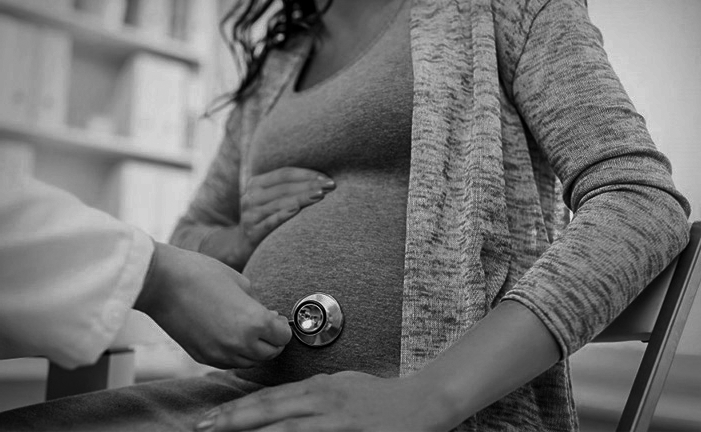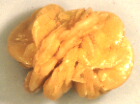
Facts and Information
 The incidence of calculi during pregnancy is 1 in 1500. Pregnancy does not pose an increase risk to the formation of urinary calculi. The signs and symptoms of renal colic are the same in the nonpregnant patient, but these symptoms may mimic the symptoms of pregnancy itself. Symptoms may include flank and abdominal pain, nausea and vomiting, and irritable voiding symptoms.
The incidence of calculi during pregnancy is 1 in 1500. Pregnancy does not pose an increase risk to the formation of urinary calculi. The signs and symptoms of renal colic are the same in the nonpregnant patient, but these symptoms may mimic the symptoms of pregnancy itself. Symptoms may include flank and abdominal pain, nausea and vomiting, and irritable voiding symptoms.
There is a 5% incidence of bacteruria and 20-40% of these patients will develop symptomatic UTI's or pyelonephritis. Most renal calculi are diagnosed during the second and third trimester of pregnancy. The hallmark of therapy is conservative treatment, since 50-67% of these patients will pass their stones spontaneously. Conservative management includes analgesics, hydration and close follow-up.
Despite these measures, some pregnant patients with stones may have persistent pain, fever or an obstructed kidney requiring surgical intervention. Surgery during the first trimester can result in spontaneous abortion. Surgery during the third trimester can result in premature delivery. During the second trimester, there is a window of opportunity for surgical intervention should the patient require this.
Radiation Exposure
Radiation exposure of the mother and fetus should be minimal if not prevented. Radiation exposure during the first trimester may result in a 2.5-5% risk to the fetus. There is a 1.6 relative risk of leukemia, a 3.2 relative risk of solid childhood cancers and an overall relative risk of 2.4 for all childhood malignancies. Patients can be screened by ultrasound without any risk to the fetus. It would be prudent to avoid any radiation to the fetus during gestation, unless the radiographic study will have a major impact on the stone management of the patient. Magnetic resonance imaging (MRI) may be a safer alternative than radiation when ultrasound is found to be inconclusive. However, there are no large series addressing the role of MRI in the management of renal calculi during pregnancy. Vaginal sonography is now being used to diagnose distal ureteral stones. Doppler ultrasound can be used to measure intrarenal resistive indices to differentiate physiologic from obstructive hydronephrosis. The presence of ureteral jets on ultrasound can be interpreted as evidence that obstruction is unlikely. Endoluminal ultrasound is being utilized as a tool to facilitate ureteral stent placement.
Treatment
Surgical procedures can be performed safely under epidural anesthesia. If treatment is required, therapy should be conservative. Upper tract drainage in the form of a ureteral stent placed under ultrasound guidance should be adequate to relieve the obstruction, drain infected urine, preserve renal function and relief of symptoms. These patients are left with a ureteral stent and definitive treatment of the stone is performed after the pregnancy. Some urologists advocate ureteroscopy and stone extraction. Ureteroscopy during pregnancy has been used successfully but may pose a risk to the mother and fetus. Alternatively, if placement of a stent or removal of the stone is not possible, some will advocate the placement of a nephrostomy tube under ultrasonic guidance. This will allow drainage of urine from the obstructed kidney and the definitive stone management is left until after the delivery. ESWL has not been approved for use during pregnancy. In a small percentage of patients, open surgery to remove stones may be indicated.
Risks
Due to the association of infection and premature labor, patients should have their urine screened monthly. Untreated UTI's during pregnancy can result in premature delivery, low birth weight of the fetus and pyelonephritis in the mother.
Antibiotics
Antibiotics that can be given during pregnancy:
-
- Penicillins
- Cephalosporins
- Erythromycin
Antibiotics that should be avoided during pregnancy. Risk to the fetus:
-
- Trimethoprim is teratogenic during the first trimester.
- Sulfur can result in Kernicterus or hemolysis (G6PD) during the third trimester.
- Chloramphenicol can cause Gray syndrome.
- Tetracycline can result in discoloration of teeth (tooth dyplasia), inhibition of bone growth.
- Aminoglycosides can cause CNS toxicity, ototoxicity.
- Isoniazid can cause neuropathy, seizures.
- Trimethoprim-sulfamethoxazole can cause folate antagonism.
- Quinolones can cause abnormalities in bone growth.
- Nitrofurantoin can cause hemolysis (G6PD).
Antibiotics that should be avoided during pregnancy. Risk to the mother:
-
- Sulfur can result in allergies.
- Chloramphenicol can cause marrow toxicity.
- Tetracycline can result in hepatotoxicity and renal failure.
- Aminoglycosides can cause ototoxicity and nephrotoxicity.
- Isoniazid can cause hepatotoxicity.
- Trimethoprim-sulfamethoxazole can cause vasculitis.
- Quinolones can cause allergies.
- Nitrofurantoin can cause interstitial pneumonia or neuropathy.
 The incidence of calculi during pregnancy is 1 in 1500. Pregnancy does not pose an increase risk to the formation of urinary calculi. The signs and symptoms of renal colic are the same in the nonpregnant patient, but these symptoms may mimic the symptoms of pregnancy itself. Symptoms may include flank and abdominal pain, nausea and vomiting, and irritable voiding symptoms.
The incidence of calculi during pregnancy is 1 in 1500. Pregnancy does not pose an increase risk to the formation of urinary calculi. The signs and symptoms of renal colic are the same in the nonpregnant patient, but these symptoms may mimic the symptoms of pregnancy itself. Symptoms may include flank and abdominal pain, nausea and vomiting, and irritable voiding symptoms.
There is a 5% incidence of bacteruria and 20-40% of these patients will develop symptomatic UTI's or pyelonephritis. Most renal calculi are diagnosed during the second and third trimester of pregnancy. The hallmark of therapy is conservative treatment, since 50-67% of these patients will pass their stones spontaneously. Conservative management includes analgesics, hydration and close follow-up.
Despite these measures, some pregnant patients with stones may have persistent pain, fever or an obstructed kidney requiring surgical intervention. Surgery during the first trimester can result in spontaneous abortion. Surgery during the third trimester can result in premature delivery. During the second trimester, there is a window of opportunity for surgical intervention should the patient require this.
Radiation exposure of the mother and fetus should be minimal if not prevented. Radiation exposure during the first trimester may result in a 2.5-5% risk to the fetus. There is a 1.6 relative risk of leukemia, a 3.2 relative risk of solid childhood cancers and an overall relative risk of 2.4 for all childhood malignancies. Patients can be screened by ultrasound without any risk to the fetus. It would be prudent to avoid any radiation to the fetus during gestation, unless the radiographic study will have a major impact on the stone management of the patient. Magnetic resonance imaging (MRI) may be a safer alternative than radiation when ultrasound is found to be inconclusive. However, there are no large series addressing the role of MRI in the management of renal calculi during pregnancy. Vaginal sonography is now being used to diagnose distal ureteral stones. Doppler ultrasound can be used to measure intrarenal resistive indices to differentiate physiologic from obstructive hydronephrosis. The presence of ureteral jets on ultrasound can be interpreted as evidence that obstruction is unlikely. Endoluminal ultrasound is being utilized as a tool to facilitate ureteral stent placement.
Surgical procedures can be performed safely under epidural anesthesia. If treatment is required, therapy should be conservative. Upper tract drainage in the form of a ureteral stent placed under ultrasound guidance should be adequate to relieve the obstruction, drain infected urine, preserve renal function and relief of symptoms. These patients are left with a ureteral stent and definitive treatment of the stone is performed after the pregnancy. Some urologists advocate ureteroscopy and stone extraction. Ureteroscopy during pregnancy has been used successfully but may pose a risk to the mother and fetus. Alternatively, if placement of a stent or removal of the stone is not possible, some will advocate the placement of a nephrostomy tube under ultrasonic guidance. This will allow drainage of urine from the obstructed kidney and the definitive stone management is left until after the delivery. ESWL has not been approved for use during pregnancy. In a small percentage of patients, open surgery to remove stones may be indicated.
Due to the association of infection and premature labor, patients should have their urine screened monthly. Untreated UTI's during pregnancy can result in premature delivery, low birth weight of the fetus and pyelonephritis in the mother.
Antibiotics that can be given during pregnancy:
-
- Penicillins
- Cephalosporins
- Erythromycin
Antibiotics that should be avoided during pregnancy. Risk to the fetus:
-
- Trimethoprim is teratogenic during the first trimester.
- Sulfur can result in Kernicterus or hemolysis (G6PD) during the third trimester.
- Chloramphenicol can cause Gray syndrome.
- Tetracycline can result in discoloration of teeth (tooth dyplasia), inhibition of bone growth.
- Aminoglycosides can cause CNS toxicity, ototoxicity.
- Isoniazid can cause neuropathy, seizures.
- Trimethoprim-sulfamethoxazole can cause folate antagonism.
- Quinolones can cause abnormalities in bone growth.
- Nitrofurantoin can cause hemolysis (G6PD).
Antibiotics that should be avoided during pregnancy. Risk to the mother:
-
- Sulfur can result in allergies.
- Chloramphenicol can cause marrow toxicity.
- Tetracycline can result in hepatotoxicity and renal failure.
- Aminoglycosides can cause ototoxicity and nephrotoxicity.
- Isoniazid can cause hepatotoxicity.
- Trimethoprim-sulfamethoxazole can cause vasculitis.
- Quinolones can cause allergies.
- Nitrofurantoin can cause interstitial pneumonia or neuropathy.
Suggested Readings
Hendricks SK, Russ SO, Krieger JN: An algorithm for diagnosis and therapy of mangement and complications of urolithiasis during pregnancy. Surg Gynec Obstet 172: 49-54, 1991. Colombo PA, Pittino R, Pascalino MC, et al: Control of uterine contraction with tocolytic agents. Ann Obstet Gynecol Med Perinatal 102:431-440, 1981.
Broaddus SB, Catalano PM, Leadbetter GW Jr, et al: Cessation of premature labor following removal of distal ureteral calculus. Am J Obstet Gynecol 143:846-848, 1982.
Loughlin KR, Bailey RB Jr: Internal ureteral stents for conservative management of ureteral calculi during pregnancy. New Eng J Med
315:1647-1649, 1986.
Gluck CD, Benson CB, Bundy AL, et al: Ultrasonic guidance of placement of ureteral stents in pregnancy. J Endourol 5:241-243, 1991.
Jarrard DJ, Gerber GS, Lyon ES: Management of acute ureteral obstruction in pregnancy utilizing ultrasound-guided placement of ureteral stents. Urol 42:263-268, 1993. Harvey EB, Boice JD, Honeyman M, et al: Prenatal x-ray exposure and childhood cancer in twins. NEJM 312:541-545, 1985.
MacMahon B: Prenatal x-ray exposure and childhood cancer. JNCI
28:1173-1191, 1962. Mole RH: Antenatal irradiation and childhood cancer: Causation or coincidence? Br J Cancer 30:199-208, 1974.
Laing F, Benson CB, Frates M, et al: Sonographic detection of distal ureteral calculi by vaginal sonography. Presented at the Radiologic Society of North America Annual Meeting, Chicago, IL, November, 1993.
Platt JF: Duplex Doppler evaluation of native kidney dysfunction: Obstructive and non-obstructive disease. Am J Roentgenol 158:1035-1042, 1992.
Hertzberg BS, Carrol BA, Bowie JD, et al: Doppler US assessment of maternal kidneys: Analysis of intrarenal resistivity idexes in normal pregnancy and physiologic pelvicaliectasis. Radiology 186:689-692, 1993.
Jarrard DJ, Gerber GS, Lyon ES: Management of acute ureteral obstruction in pregnancy utilizing ultrasound-guided placement of ureteral stents. Urology 42:263-268, 1993. Wolf MC, Hollander JB, Salisz JA, et al: A new technique for ureteral stent placement during pregnancy using endoluminal ultrasound. Surg Gynecol Obstet 175:575-576, 1992.
Rittenberg MH, Bagley DH: Ureteroscopic diagnosis and treatment of urinary calculi during pregnancy. Urology 32:427-428, 1988.
Scarpa RM, DeLisa A, Usai E: Diagnosis and treatment of ureteral calculi during pregnancy with rigid ureteroscopes. J Urol 155:875-877, 1996.
Smith DP, Graham JB, Prystowsky JB, et al: The effects of ultrasound-guided shock waves during early pregnancy in Sprague-Dawley rats. J Urol
145:257A, 1991.
Loughln KR: Management of urologic problems during pregnancy. Urology 44:159-169, 1994.
